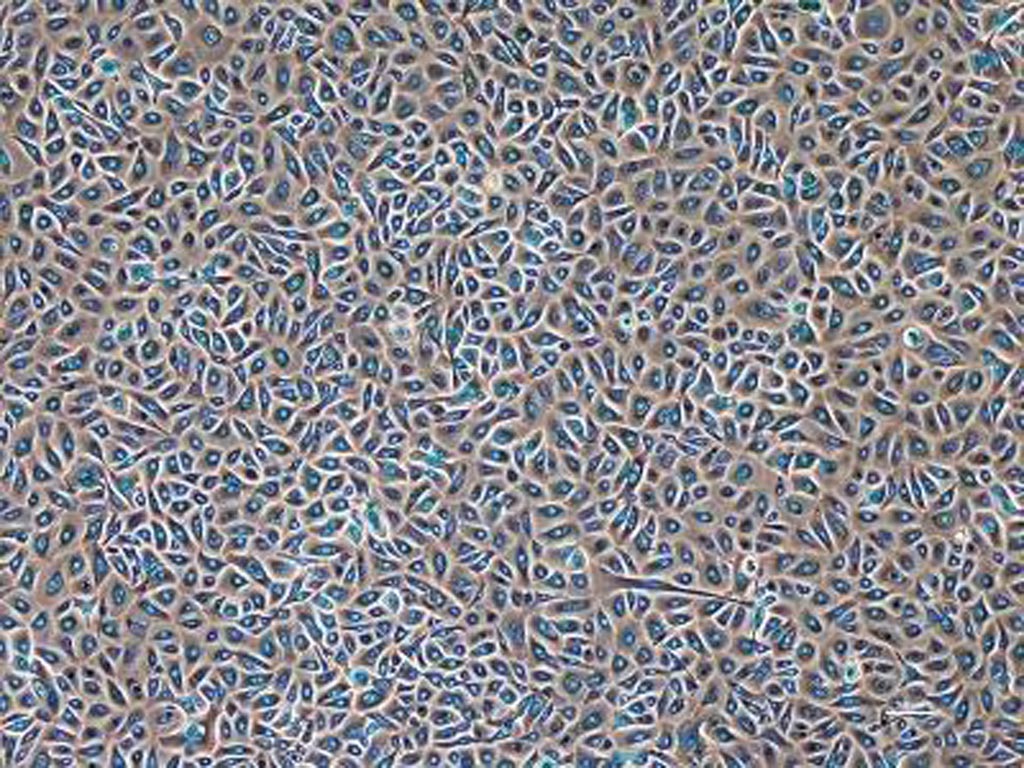Preconditioning Enhances Stem Cell Transplantation in CF Model
By LabMedica International staff writers
Posted on 15 Aug 2018
Disruption of the epithelial cell layer using the agent polidocanol was found to facilitate effective transplantation of cultured stem cells into nasal airways in a mouse model of cystic fibrosis.Posted on 15 Aug 2018
Polidocanol, which is formed by the ethoxylation of dodecanol, is a local anesthetic and antipruritic compound, which is also used as a sclerosant, an irritant injected to treat varicose veins. Polidocanol works by damaging the cell lining of blood vessels, causing them to close and eventually be replaced by other types of tissue.

Image: Gene therapy treated airway stem cells (Photo courtesy of Dr. Nigel Farrow, University of Adelaide).
CF is inherited in an autosomal recessive manner. It is caused by the presence of mutations in both copies of the gene for the cystic fibrosis transmembrane conductance regulator (CFTR) protein. Those with a single working copy are carriers and otherwise mostly normal. CFTR is involved in production of sweat, digestive fluids, and mucus. When CFTR is not functional, secretions, which are usually thin instead become thick. Airway disease is a primary cause of morbidity and early mortality for patients with CF.
The focus of much CF gene therapy research has been aimed at trying to place a normal copy of the CFTR gene into affected cells. Transferring the normal CFTR gene into the affected epithelium cells would result in the production of functional CFTR protein in all target cells, without adverse reactions or an inflammation response. To prevent the lung manifestations of CF, only 5-10% the normal amount of CFTR gene expression is needed. Multiple approaches have been tested for gene transfer, such as liposomes and viral vectors in animal models and clinical trials. However, both methods were found to be relatively inefficient treatment options, mainly because very few cells take up the vector and express the gene, so the treatment has little effect.
Since in vivo cell delivery into unconditioned mouse airways has not been very successful, investigators at the University of Adelaide (Australia) hypothesized that disrupting the epithelial cell layer using the agent polidocanol (PDOC) would facilitate effective transplantation of cultured stem cells.
They tested this theory by administering PDOC in phosphate-buffered saline to the nasal airway of mice to disrupt the epithelium. At two or 24 hours after PDOC treatment, two types of reporter gene-expressing cells were transplanted into the animals: luciferase-transduced human airway basal cells (hABC-Luc) or luciferase-transduced human amnion epithelial cells (hAEC-Luc). Bioluminescence imaging was used to assess the presence of transplanted luciferase-expressing cells over time.
Results published in the June 13, 2018, online edition of the journal Stem Cell Research and Therapy revealed that successful transplantation occurred when hABCs were delivered two hours after PDOC but was absent when transplantation was performed 24 hours after PDOC, suggesting that a greater competitive advantage for the donor cells was present at the earlier time point. The lack of transplantation of hAECs 24 hours after PDOC supported the importance of choosing the correct timing and cell type to facilitate transplantation.
"There are 70,000 people worldwide living with CF for which there is currently no cure, and disease in the lungs is the major cause of poor health and a significantly shortened life span," said first author Dr. Nigel Farrow, a post-doctoral research fellow at the University of Adelaide. "Our research which applies stem cell transplantation, involves harvesting adult stem cells from the lungs of CF patients, correcting them with gene therapy, and then reintroducing those cells back into the patient. The new transplanted adult stem cells pass on their healthy genes to their "daughter cells" providing a constant means to replenish the airways with healthy cells, and thereby combatting the onset of cystic fibrosis airway disease."
"The key to these successful transplantations was our innovative method; we first eliminated the existing surface cells, which then created the space required to introduce the new cells," said Dr. Farrow. "If we can perfect this technique, it will accelerate this exciting research which could significantly improve the lives of those living with cystic fibrosis and potentially combat this chronic life-limiting illness."
Related Links:
University of Adelaide













